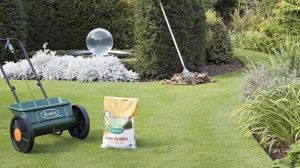Don’t let your lawn go hungry this summer. Find out how to feed it properly and ensure a luxurious carpet of green with this handy fertiliser guide.
Like any living thing, lawns love being fed. Offer your lawn an all-you-can-eat buffet, and it will reward you with lush growth all summer long. Regular applications of fertiliser and water is a simple enough task, but with the huge range of fertilisers available to garden owners nowadays, picking the right one for what you want to achieve can be confusing.

Essentially, a balanced fertiliser is one that contains all three of the essential growth-producing elements:
- Nitrogen (N). Known as the leaf-maker, it stimulates the growth of foliage, improves leaf colour and increases the size of plants.
- Phosphorus (P). Known as the root-maker, it boosts root growth and the germination of seeds.
- Potassium (K). Known as the flower- and fruit-maker, it improves the quality of fruits and flowers and is a general growth booster.
When choosing a fertiliser, you will come across a number on the bag that looks like this: 2:3:2 (22). This refers to the ratio of the elements needed for specific plants – N:P:K – and you can choose which ratio you want depending on what you are growing.
A good general fertiliser for all lawn types is 5:1:5 (36). This ratio indicates a fertiliser high in nitrogen and potassium. The (36) indicates the percentage of these three elements in the mix. There are also specialised lawn fertilisers available, made especially for lawns.
Find the best prices on fertiliser online with PriceCheck now:
When and how to apply
Apply fertiliser at a rate of 60g per square metre during the growing season at least once every three months. A nitrogen-rich feed is a good idea in spring to boost leaf growth and thereafter a 5:1:5 or controlled released LAN.

If you are experiencing dry conditions or water restrictions, rather avoid fertilising as it can burn your lawn if not watered well.
Although not essential, you can feed your lawn during winter using a 2:3:2 fertiliser, which contains less nitrogen and more phosphorus. Most lawns become dormant in winter, so they don’t need high volumes of nitrogen.
Spread the fertiliser evenly using a special spreader or the back of a rake.
Find the best prices on lawnmowers online with PriceCheck now:
Chemical versus organic
Chemical fertilisers are a man-made combination of elements formulated to give plants immediate access to the nutrients they require. Excessive use of these can, over time, lead to a loss of natural, water-soluble plant nutrients from the soil.

Organic fertilisers are made up of natural materials and are by nature slow release. They often include micro-elements, which result in a more balanced diet for plants, and they condition the soil while feeding the plant. More regular application of an organic fertiliser is advised for best results.
Also read: Tips to Get your Lawn in tip-top shape
Tips for success
- Slow-release fertilisers are best to use on your lawn, indicated by the letters ‘SR’ after the number on the bag. These provide your green carpet with all the important nutrients for up to six months.
- Water your lawn a few days before you fertilise to make sure it isn’t suffering from drought stress.
- Water the fertiliser immediately after applying to avoid fertiliser burn.
- Apply extra fertiliser after a particularly rainy season to replace nutrients leached from the soil.
Find the best prices on gardening essentials online with PriceCheck now:




